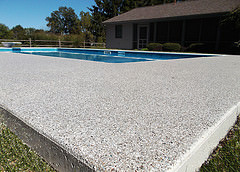How Does Concrete Resurfacing Work?
 Spring is here! Time to inspect your outdoor space to see how your hardscape has survived the winter and repair any damage. (Hardscape, in case you're wondering, refers to the manmade features of a property's landscaping such as patios, sidewalks, pool decks, retaining walls, driveways, and fire pits.) If concrete installations look much the worse for wear, this year is an excellent time to consider resurfacing. Resurfacing is a relatively simple and inexpensive process of refinishing worn or damaged concrete, which covers up wear and tear and gives a fresh new look, without major hassle or expense. Find out more.
Spring is here! Time to inspect your outdoor space to see how your hardscape has survived the winter and repair any damage. (Hardscape, in case you're wondering, refers to the manmade features of a property's landscaping such as patios, sidewalks, pool decks, retaining walls, driveways, and fire pits.) If concrete installations look much the worse for wear, this year is an excellent time to consider resurfacing. Resurfacing is a relatively simple and inexpensive process of refinishing worn or damaged concrete, which covers up wear and tear and gives a fresh new look, without major hassle or expense. Find out more.
Types of Concrete Damage
Concrete can become damaged for two main reasons: 1) mishandling of the initial installation process or 2) the effects of time, harsh weather, and use.
Spalling is a rough, pitted surface that is the result of a concrete mix that contained proportionally too much water or that was not properly cured after pouring.
Cracking is actually a normal, albeit ugly, reaction of concrete, which can be disguised by building in control joints (sidewalk lines or a decorative pattern) at the time of installation. As long as the crack is minor and does not run all the way through the concrete, it can be repaired using resurfacer.
Fading may occur over time, as the concrete hardscape is exposed to strong sunlight and severe winters, while staining and wear are common on high traffic paths, decks, or driveways.
What is Concrete Resurfacer?
Concrete resurfacer is made of much the same ingredients as concrete itself (Portland cement and sand) but with the addition of a polymer bonding agent to help fill in divots or pitted areas and prevent shrinkage. The resurfacer comes in a dark gray color; you will probably find it difficult to match the existing concrete exactly, so it's advisable to coat the entire structure for the sake of a uniform appearance. To add an interesting color, you can blend a tint into the resurfacing mixture. Buy resurfacer in 40-pound bags, which will cover approximately 40-50 square feet, depending on how thick you spread the product.
Tips for Applying Concrete Resurfacer
- If you have ever installed concrete, you will find that resurfacer is much less demanding to work with, especially if you resurface small sections at a time.
- The compound pours and spreads easily with the help of a long-handled squeegee, and is self-leveling.
- Concrete resurfacing requires only a moderate level of skill as a DIY project. If you prefer, you can hire a concrete professional for the work.
- You will need to clean the surface with a pressure washer before applying the concrete resurfacer, and after the job is done, leave it to dry undisturbed for a minimum of six hours.
- If you would like to create a highly slip-resistant finish, brush the surface with a nylon-bristled broom while it is still wet.
- Should the spring weather in your region be unpredictable still, you might want to hold off on resurfacing for a few more weeks. It works best when it is applied early in the morning on a mild day, when the temperature is forecast to remain above 50 degrees for at least 8 hours. The newly refinished area will need protection if an unexpected rainstorm comes along while it is drying.
Laura Firszt writes for networx.com.
Updated May 15, 2018.
Looking for a Pro? Call us (866) 441-6648

Concrete Average Costs
Concrete Contractors Experiences

New Concrete Driveway Tough Enough For Farm Vehicles

Concrete Patio Is The Finishing Touch For An Artist's Studio



